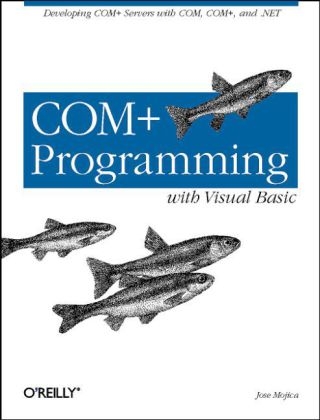
COM+ Programming with Visual Basic
O'Reilly Media (Verlag)
978-1-56592-840-4 (ISBN)
- Titel ist leider vergriffen;
keine Neuauflage - Artikel merken
The Visual Basic programming environment is designed to hide as many low-level system details as possible. While this approach can speed development time by allowing the developer to focus on the task at hand, it actually hinders the process when it obscures details the developer needs to understand or control. Such is often the case for programmers who are developing components that take advantage of COM+ services. "COM+ Programming with Visual Basic" addresses the information needs of these developers. For instance, despite the marketing hype about COM+ as the new and improved version of COM, classic COM is very much the foundation on which COM+ is built: COM+ components are a particular kind of COM component. Visual Basic hides almost all COM implementation details; yet it is precisely in the area of COM+ programming that these hidden details are most important. Therefore, the text devotes significant content to exploring COM internals: interface-based programming; how COM interfaces work internally; how COM components are activated; and how versioning COM components works in Visual Basic.
The second section focuses on incorporating individual COM+ services, like transaction support, security, and asynchronous operations, into applications. The author concludes by discussing what developers need to learn to transition to Microsoft's coming .NET framework. Regardless of what lies ahead for .NET, many distributed systems are being built today with COM+. COM+ Programming with Visual Basic focuses on topics relevant to distributed applications that are here to stay: how to use interfaces; passing objects by reference or by value; what it means to have multithreaded applications; how declarative programming works; how to program within a distributed transaction; and how to add role-based security to applications.
Jose Mojica is an instructor and researcher at DevelopMentor, a company that's gained an international reputation for its experience with COM and COM+. He teaches various courses that focus on enterprise development in COM+, IIS, and Visual Basic. Before joining DevelopMentor, Jose was a consultant at IBM, writing DCOM servers that performed speech recognition and creating ActiveX controls in ATL for the ViaVoice SDK. He has worked with Visual Basic since Version 1.0. Jose is the author of Building ActiveX Controls with Visual Basic 5.0 and coauthor of Programming Internet Controls and the Microsoft MCSD Training Kit, Distributed Applications for Visual C++ 6.0.
Preface 1. COM+ Internals What Is COM+? COM and COM+ Knowing the Internals Introduction to .NET 2. Interface-Based Programming Why Interface-Based Programming? Defining Interfaces in Visual Basic Using a Class Through an Interface Polymorphism I (Multiple Components-Single Interface) Polymorphism II (Single Component-Multiple Interfaces) Review 3. How Interfaces Work Internally Life Without Interfaces Memory Layout of Interfaces COM as a Binary Standard Type Libraries COM Standard Interfaces: IUnknown and IDispatch Summary 4. In-Process Servers Client-Server Communication: A High-Level View Client-Server Communication: A Low-Level View 5. Out-of-Process Servers and COM's Remoting Architecture ActiveX EXEs Threads Remoting and Location Transparency Pinging Mechanism Summary 6. Versioning The Goal of COM Versioning Client Requirements COM's Versioning Story How Visual Basic Versions Your COM Objects Using IDL Summary 7. COM+ Applications Creating a COM+ Application Services Overview COM+ Administration Components Summary 8. Writing and Debugging COM+ Code COM+ Architecture Debugging COM+ Applications 9. Transaction Services What Is a Transaction? Declarative Transactions Summary 10. COM+ Security Security Terminology RPC Security COM/COM+ Security Internet-Based Security Summary 11. Introduction to .NET The .NET Architecture Developing Assemblies VB.NET Features Mixing COM+ and .NET Using COM+ Services Summary Index
| Erscheint lt. Verlag | 24.7.2001 |
|---|---|
| Verlagsort | Sebastopol |
| Sprache | englisch |
| Einbandart | kartoniert |
| Themenwelt | Informatik ► Programmiersprachen / -werkzeuge ► Visual Basic |
| ISBN-10 | 1-56592-840-7 / 1565928407 |
| ISBN-13 | 978-1-56592-840-4 / 9781565928404 |
| Zustand | Neuware |
| Haben Sie eine Frage zum Produkt? |
aus dem Bereich
